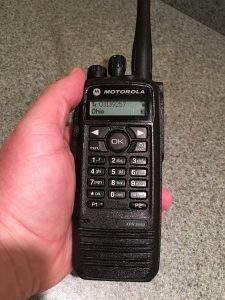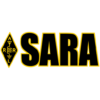 The Motorola XPR-6550 is different from the other ham radio oriented radios that are part of this review series. It is built for commercial and business operations, not for ham radio. You’ll often see the XPR-6550 hanging on the belt of police and fire personnel, factory workers and hotel/event staff. The radio is single band – covering ONLY VHF or UHF depending on the model you get (mine in this review is UHF only), and can be had on the used market for between $180 and $250. The radio does both analog FM and DMR, including Motorola’s DMR-compatible enhanced MotoTRBO.
The Motorola XPR-6550 is different from the other ham radio oriented radios that are part of this review series. It is built for commercial and business operations, not for ham radio. You’ll often see the XPR-6550 hanging on the belt of police and fire personnel, factory workers and hotel/event staff. The radio is single band – covering ONLY VHF or UHF depending on the model you get (mine in this review is UHF only), and can be had on the used market for between $180 and $250. The radio does both analog FM and DMR, including Motorola’s DMR-compatible enhanced MotoTRBO.What makes this a commercial/business radio rather than a ham unit includes:
- You cannot program the radio from the front panel by design. Some features are available in menus from the front panel such as scan options, but you cannot punch in a new frequency, PL tone, etc on the fly without connecting a computer to the radio to program it. It does not have the notion of a VFO.
- Out of the box, you cannot program the radio to use the FM “wide” mode that us used in most ham radio systems. This radio is only narrow band (12.5 KHz spacing) unless you purchase a separate license from Motorola.
- It does not have the capability to hold 100,000 contacts and talkgroups like many of the ham radio oriented rigs do.
- Many would argue that “commercial” service radios are built better and are sturdier than most ham oriented units.
- I have found the features on this radio to be 100% bug-free on both analog and digital modes. You turn the radio on and use it, and it always works. While it has fewer features than most other ham rigs, the features it does have just work.
- You cannot download the programming software from Motorola. You must buy it from Motorola for $400, after going through a rather antiquated process to establish your account that allows you to pay them. And for your $400, you’re really only buying a license to use it for 3 years that legally needs to be renewed after that period. If you already happen to know someone that can program the radio, you may be able to avoid this cost. The purchasing system is designed to support the dealer network, not to support hams.
Pros
- This radio is built like a tank. The plastic is thicker, feels better, and is more solid than any other handheld radio I own. The buttons all feel super-high quality as well with a nice action.
- The receive and transmit audio are also the best of any handheld I own. You can turn the volume down to a whisper or up so loud you can’t be in the car with it, and it’s crystal clear all the time. With the proper “Wide band entitlement” license, this radio sounds distinctively good on analog and solid on DMR modes.
- The DMR and analog features are 100% bug free (although somewhat limited). Unlike radios from Tytera, Anytone, and Radioditty, this radio implements the DMR protocol to specification so that receive groups, admit criteria, scan, and text messaging work exactly the way they are supposed to.
- The radio is “type accepted”, meaning that if you are properly licensed, you can legally use this radio on GMRS and business/commercial/public safety systems. Even though many ham radios can be modified to transmit “out of band”, it is NOT legal to use most ham gear on commercial & public service systems EVEN IF YOU ARE LICENSED to do so. You can use this radio on all of the above.
Cons
- Programming this radio for ham radio use is not something Motorola encourages. $400 for a 3 year license plus other headaches make that clear. Add to that the fact that you cannot program the radio from the front panel at all, and you have a fairly inflexible rig for ham use.
- It’s one of the largest and heaviest handhelds I have.
- It is only available in single band. There is no dual band version of this radio.
- Only DTMF digits 0-9, * and # are supported – not the extra A,B,C,D that is on most radios. Most people won’t find this to be a problem, but A,B.C and D are sometimes used by control operators on repeaters for certain codes.
To sum it up, I’d probably steer away from the Motorola XPR-6550 for ham radio use unless you either can obtain one very inexpensively and know you have what you need to program it, or if your tolerance for bugs is so low that you’re willing to put up with all the Motorolaness.
